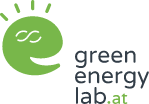Research aims to enable rapid expansion of photovoltaics
By 2030, the installed photovoltaic capacity throughout Austria is to be increased to 21 gigawatts. By 2040, the target is even 41 gigawatts – more than 14 times the level of 2021. To ensure that the grid can cope with this exponential growth, Green Energy Lab is conducting research into innovative solutions for integrating PV systems into the energy system.
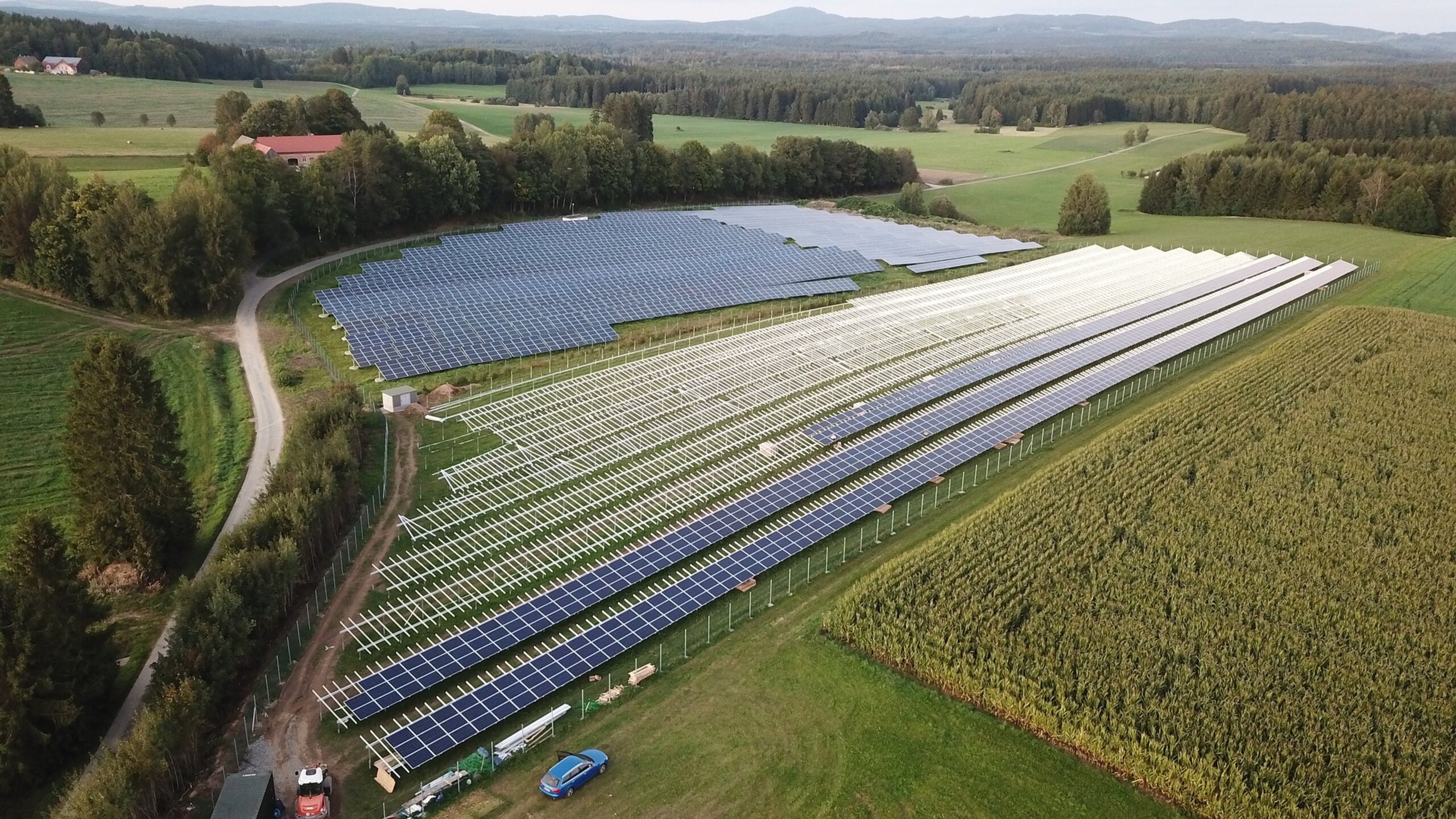
© by fabersam via Pixabay
Vienna, 23 October 2025 – The expansion of photovoltaics is progressing rapidly. Currently, around nine gigawatts of photovoltaic capacity are installed in Austria, which already covers more than 10 per cent of Austria’s electricity needs. But that is by no means the end of the story: by 2030, PV capacity is planned to be expanded to a total of 21 gigawatts, and by 2040 to 41 gigawatts.
The “installed capacity” is the sum of the peak outputs of all PV systems. The actual electricity generation is subject to strong fluctuations throughout the day and depends on the season and the respective weather conditions. This volatility must be balanced out. It is also important to keep an eye on the space requirements and integrate photovoltaic modules into functional buildings as much as possible. In the broad-based research project “Engage PV” from the “Green Energy Lab” innovation laboratory, scientists and energy suppliers are working together to develop strategies and methods for the systemic integration of PV systems so that the expansion of photovoltaics can proceed rapidly.
“We need innovative solutions to integrate solar power into the energy system in a meaningful way. The Engage PV project provides valuable insights into this,” says Andrea Edelmann, chairwoman and spokesperson for the board of Green Energy Lab.
Double use of land: how carports can produce energy
In order to make our living spaces sustainable, we need innovative concepts for the multiple use of land. One concrete possibility is photovoltaic systems on covered parking spaces. An exemplary system was implemented as part of the “Smart Module Systems for Carports” pilot project in Lower Austria.
One of Austria’s largest electric charging parks recently opened right next to the “Amstetten West” motorway exit. The facility has 40 fast charging stations operated by EVN, Ionity and Tesla, offering up to 400 kW of charging power. There is also a bistro, toilets, a playground and a dog walking area. Next to the EVN charging stations, a carport with a photovoltaic system has been built. Large glass panels with integrated PV modules serve as the roof. Milk glass on the underside ensures latent light transmission and homogeneous light distribution without harsh shadows. The specially developed PV glass modules are five metres long, suitable for overhead installation and can withstand the static loads of roof surfaces. Whereas standard PV modules tend to become dirty over time, especially at the edges, the newly developed solar panels can be installed seamlessly and are accessible for cleaning and repair purposes. The modules are produced by Ertex Solar in Amstetten. The hardened and cut-to-size glass comes from a regional manufacturer in the immediate vicinity. The installation is carried out using a mobile crane and suction plate. The PV elements can be used not only on carports, but also on railway platforms or in shopping centres – such as the Donauzentrum in Vienna – and can be individually adapted to the respective conditions.
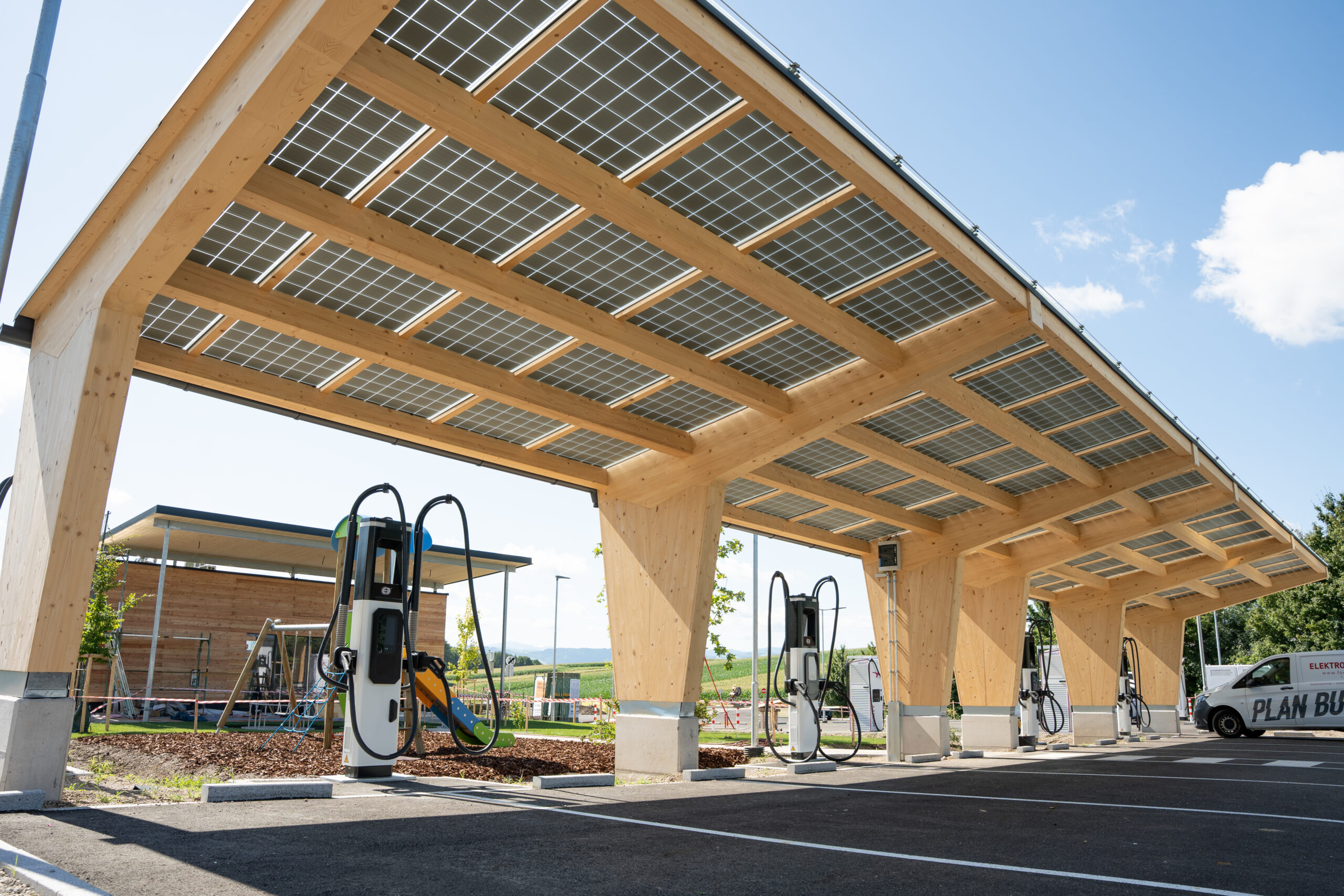
Solar canopy at the Amstetten charging park: Each module is 1080 millimetres wide and 5000 millimetres long and has an output of 918 watts. A total of 22 photovoltaic modules with a total output of 20 kWp were installed. © Stadtwerke Amstetten / Patricia Washüttl
How intelligent charging management relieves the strain on the power grid
Many private households now have photovoltaic systems. During the day, when the sun is shining, these often produce more electricity than is needed locally. In the evening, however, consumption rises, but then no solar power is available. This problem can be solved with a battery storage system. However, these storage systems are often operated inefficiently and do not relieve the power grid optimally. The batteries are usually charged with energy in the morning and are full by midday on sunny days. However, this is precisely when PV output is at its highest and is therefore fed into the grid. If many households feed into the grid at the same time around midday, this creates peak loads in the grid. This in turn can lead to feed-in restrictions and systems having to be shut down.
To avoid this, the storage systems should be charged and discharged intelligently and proactively. This approach is known as “forecast-based charging management” and is currently being tested in Unterfrauenheid in Burgenland on a single-family house with a PV system. It uses a specially developed charging management software, which is based on the weather forecast data from GeoSphere Austria.
To reduce the load on the power grid, charging of the battery storage system is deliberately delayed. To this end, the battery is automatically discharged the evening before or in the morning. This can be done through targeted power consumption or by feeding power into the grid. This empties the storage system, allowing it to absorb more power during the day. The battery is therefore only full in the late afternoon and the electricity can be used in the evening. This significantly reduces the usual feed-in peak in the middle of the day. The basis for delayed charging is formed by forecasts of energy demand, which are linked to generation forecasts based on weather data.
With an operating concept of this kind, battery storage systems for PV systems can not only optimise self-consumption, but also relieve the burden on the electricity grid. If a 100 kWp system with a local 200 kWh storage unit is operated in this way, the maximum grid feed-in can be limited to 30 kilowatts, or around one third of the PV peak output, without any losses. This would allow three times as much PV capacity to be installed – with the same grid connection capacity. “It would be important to create concrete incentives for such grid-friendly operation of electricity storage, whether through flexible tariff models or even flexible grid fees for PV feeders,” says project manager Markus Schindler.
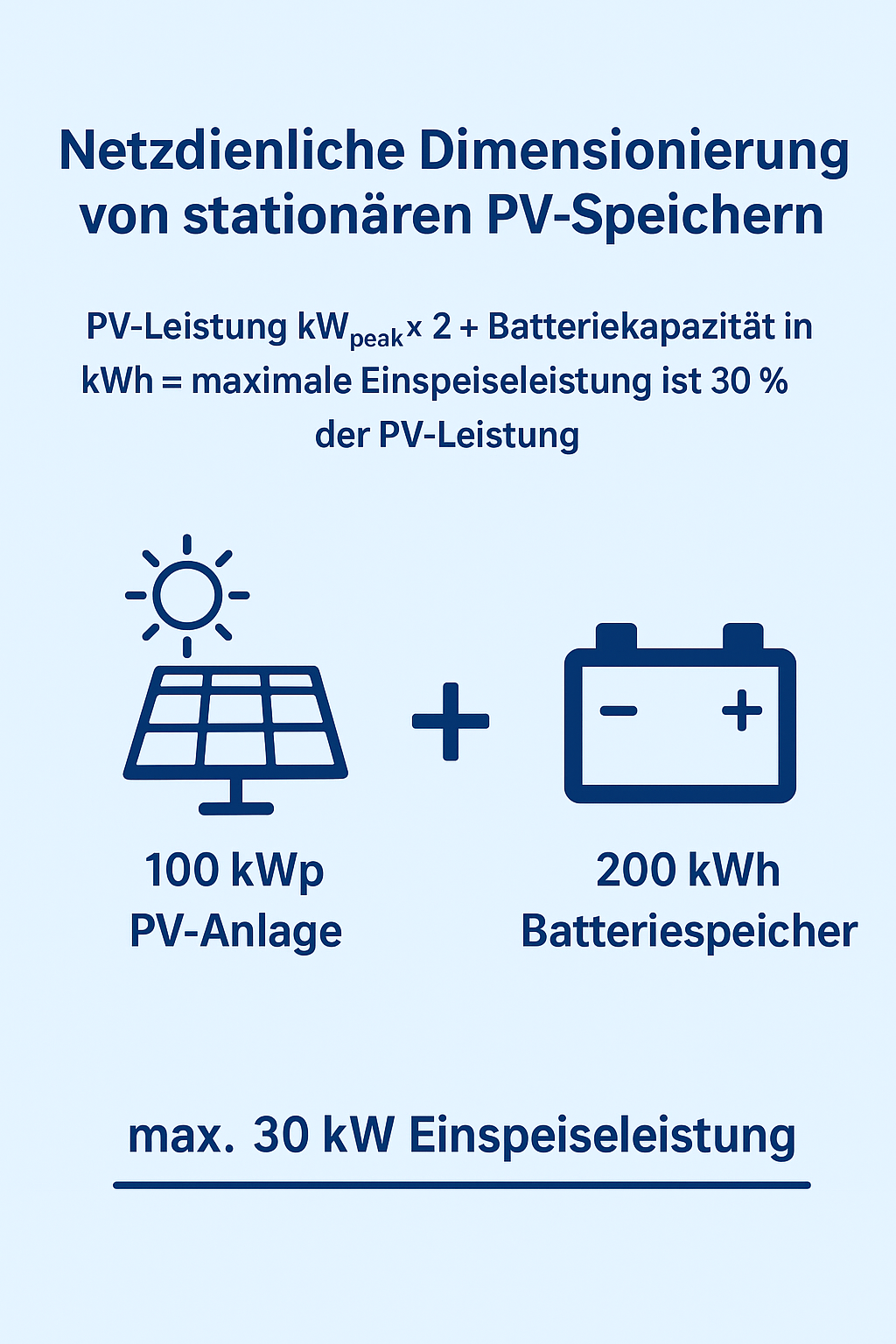
Grid-friendly dimensioning of PV storage systems. © EngagePV / Green Energy Lab
How automated planning helps communities achieve energy self-sufficiency
Another key component of the project is an innovative tool for automated energy independence planning for municipalities, which was developed by Burgenland Energie in collaboration with Energieberatung Burgenland. Based on consumption data, roof area analyses and economic feasibility assessments, fully automated energy briefings are created that provide municipalities with a clear implementation roadmap towards energy self-sufficiency. The system analyses existing buildings, identifies PV potential, provides solutions for heating and mobility, and proposes concrete implementation scenarios including financing options – from private investment to citizen participation models. Pilot municipalities in southern Burgenland were able to initiate concrete projects and make implementation decisions in just a few weeks, instead of spending months on planning as it was previously the case.
Rainer Matiasek, Head of Strategy and Corporate Development at the holding company at Burgenland Energie, explains: „Our automated energy independence planning enables us to actively support municipalities and households on their path to energy self-sufficiency with digital, innovative AI-supported tools and regional expertise. Engage PV helps us to quickly put such solutions into practice, thereby massively accelerating the widespread expansion of PV, storage, e-mobility and heating solutions.“
How redox flow batteries can contribute to grid stability
In addition to lithium batteries, redox flow batteries can also be used as a storage system to compensate for fluctuations in generation. These batteries use an electrochemical reaction to exchange ions and store energy in the form of vanadium-based liquids. As part of the Engage PV research project, the grid-friendly operation of these batteries in conjunction with solar systems is also being tested in practice. The test facility is located at CellCube’s site in Wiener Neudorf, which has a 150-kilowatt PV system on its roof.
The advantage of vanadium batteries lies in their long service life of at least 30,000 charging cycles and around 30 years. The batteries lose hardly any capacity over the years, as the electrochemical substances are contained in liquids in separate tanks and do not wear out. Unlike lithium batteries, vanadium batteries are non-flammable and there is no risk of explosion. Furthermore, vanadium is not a rare raw material and can be easily recycled. Compared to lithium batteries, the initial investment costs are higher. The economic efficiency results from the significantly longer service life.
One of the oldest vanadium redox flow batteries in operation worldwide is manufactured by CellCube and is located at EVN’s energy research park in Lichtenegg, Lower Austria. The company has been developing redox flow batteries for 25 years and has been manufacturing serial products since 2010. The batteries are primarily designed for long-term energy storage, which is why they are typically only used for discharge times of four hours or more. Redox flow batteries are therefore particularly well suited for use with photovoltaic systems, as they do not suffer any loss of capacity during daily charging and discharging. Due to their longer charging and discharging times, they are not already fully charged at midday, and their service life is roughly equivalent to that of PV systems.
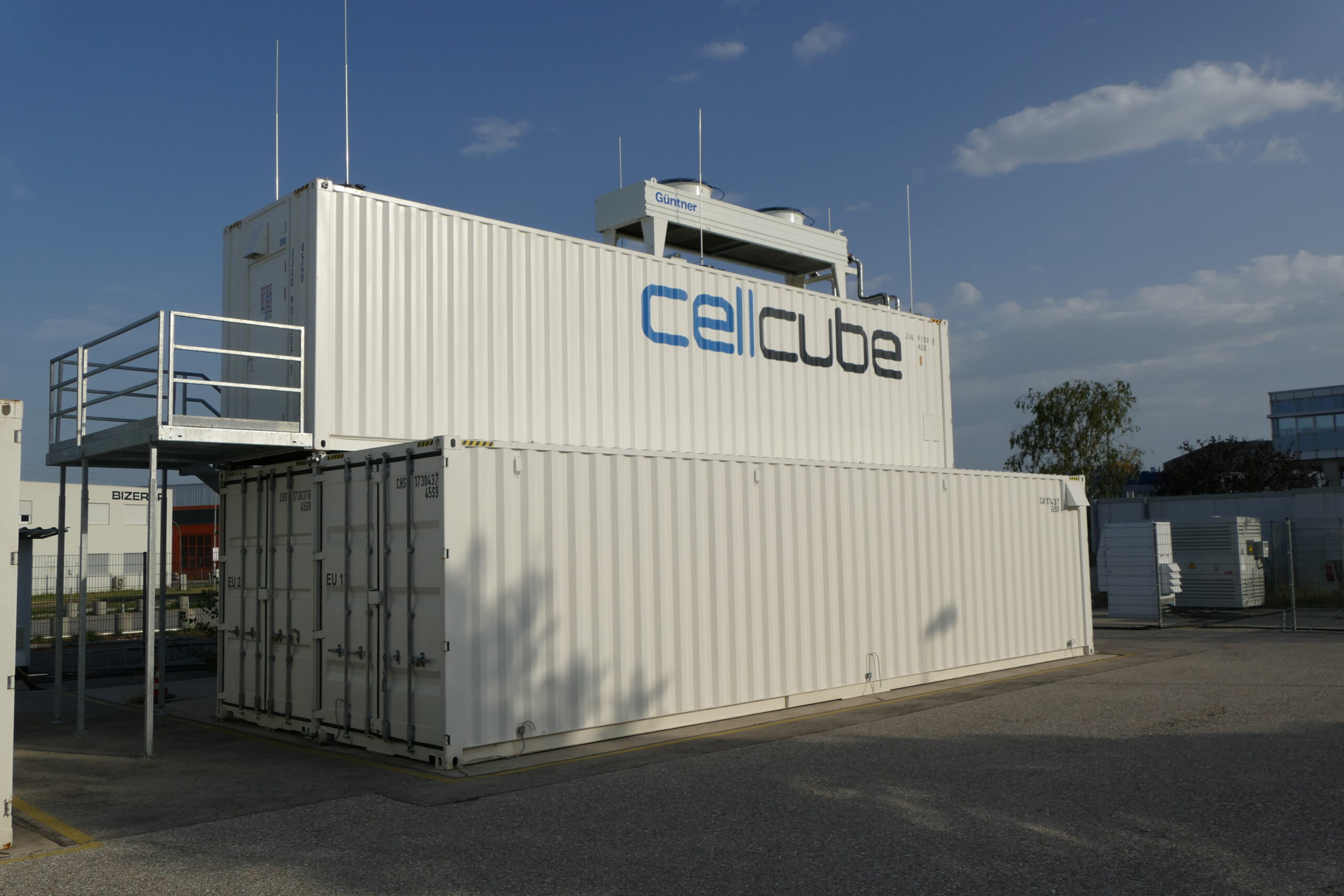
Vanadium redox flow batteries have a long service life of at least 30,000 charging cycles and approximately 30 years. © CellCube
Background information on how vanadium redox flow batteries work.
About Engage PV
The Engage PV project is funded by the Climate and Energy Fund and implemented as part of the Green Energy Lab research initiative. The aim is to develop and demonstrate social, technical and economic innovations for improved system integration of photovoltaics (PV). Methodologically, Engage PV focuses on socially acceptable and ecological land use (especially through multiple land use), promoting motivation for private PV investments, grid and system integration strategies, new generation and load forecasts, energy-efficient utilisation of the generated PV energy and its combination with other forms of generation, flexibilities, sector coupling and storage options – including virtual power plants. Project partners are Forschung Burgenland, Burgenland Energie, CellCube, CyberGrid, Enerox, ertex solartechnik, EVN, GeoSphere Austria, TU Graz, Netz Burgenland and Wind – Ingenieurbüro für Physik.
About Green Energy Lab
The Green Energy Lab research initiative is an association and incubator for applied research and innovation in the field of renewable energy and heating solutions. The founding members are four of Austria’s major energy providers: Energie Steiermark, EVN, Wien Energie and Burgenland Energie. The focus of the association’s activities is on the development, implementation and system integration of energy innovations bridging the gap between technology development and the market. Since 2018, Green Energy Lab has been operating Austria’s largest innovation laboratory for a sustainable energy future as part of the “Vorzeigeregion Energie (Flagship Region Energy)” funding programme of the Austrian Climate and Energy Fund.
Contact
Ludwig Fliesser
Communications Manager
T: +43 676 471 93 47
E: ludwig.fliesser@greenenergylab.at
